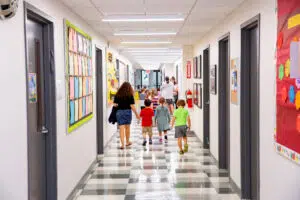Moving house often means children have to change schools. This is a consequence of the French "carte scolaire" system, which guarantees that all children attend school close to where they live. But if you move, is it really compulsory to enroll your children in the school attached to your new address? What are the formalities involved in changing schools after a move, whether primary, secondary or high school? And above and beyond the formalities, how can you prepare your children for a change of school to help them move as smoothly as possible? Find out everything you need to know about school before and after the move.
What are the consequences of a change of address for the school?
In the French education system, the allocation of students to a public school depends on the geographical area in which they live. This is the principle of school mapping.
Unless an exception is made, children are always sent to a public school close to their home. If you move, even within the same commune, your child may have to change schools. In this case, there are a number of formalities you'll need to complete to enroll your child in a new school.
Moving house and changing schools: what formalities do you need to complete?

What are the deadlines for enrolling children in their new school?
All the formalities involved in enrolling in a new school must be completed within 8 days of the move. So it's best to plan ahead!
To avoid wasting time, we advise you to inform your children's school as soon as your move is confirmed. This is an essential step in changing your children's school.
Do your children have to change schools if they move?
If you have to move during the school year, you can let your child finish the year at the same school, if he or she is in kindergarten or primary school (CP to CM2). This makes moving easier for the youngest children. A change of school during the year can be disruptive.
If you keep your child in the same class until the end of the school year, you'll have to make the daily journey to the old school. But if the school is too far from your new home, you'll have no choice but to make the necessary arrangements quickly to enroll your child in the nearest school.
At the start of the next school year, you must enroll your child in the school in your new place of residence. It is, however, possible to request an exemption to enroll your child in another public or private school.
How do you register your children in their new school?

- inform your children's school that you are moving;
- contact your local town hall to find out which school you would like to attend, and, if necessary, apply for an exemption;
- register your child at the new school. To do this, you'll need a certificat de radiation from the old school.
If you're moving house, the formalities involved in changing schools are among the priorities that need to be dealt with as quickly as possible. The sooner these formalities are completed, the better. You'll be in a better frame of mind when the big day comes. To prepare your children for the move, you'll also need to set aside some time to help them adapt.
How do you successfully change schools for your children when you move?
Completing the formalities in good time is a good start to successfully changing your children's school in the event of a move. But it's not the only condition.
Moving and enrolling in a new school: big changes for a child
To an adult, moving house usually seems like a new beginning. But for a child, moving house represents a significant change of environment, which can lead to a loss of bearings. This is particularly true of school, where a child spends a large part of his or her time.
Moving to a new place and a new school means that a child's daily life is turned upside down: change of class and teacher, separation from old friends, new spaces to find one's bearings in... To get the best possible grasp of the move and the resulting change of school, you need to be able to prepare your children.
How can you help your children adapt to their new school?

Failing that, plan a walk to school before the move to get a feel for the new surroundings and familiarize your child with his or her new school environment. After the move, on the first day of school, don't hesitate to accompany your child to reassure him or her and help them settle in.
Children generally adapt to a new environment fairly quickly. However, the situation can vary according to the age of the child: while younger children find it more difficult to adapt to the new environment, older children sometimes find it difficult to lose their friends. To speed things up, you can enroll your child in a sports or cultural club, where he or she can meet other students and make friends more quickly at school.
If you're moving to a new school, you'll need to manage the formalities involved in enrolling your children in a new establishment, and prepare them for the change. The loss of reference points associated with a move is something to be taken into account when moving house. To find out more, read our advice on moving with children.
